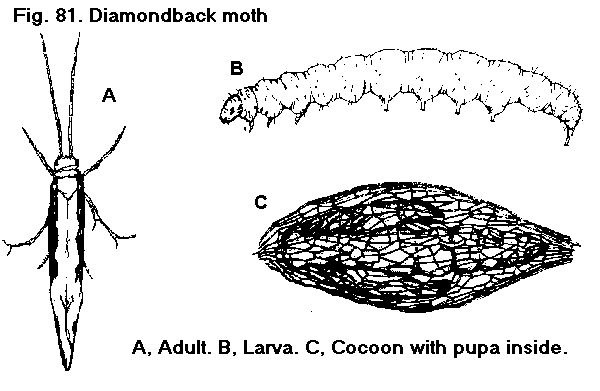
Return to: CFREC Home Page
Adult- This grayish-brown moth has narrow forewings, conspicuously fringed hind wings with a span of 18 mm. When at rest, the wings of the male come together to form a line of white or pale yellow diamonds down the middle of the back.
Egg- The minute round egg is pale yellow.
Larva- Tapering slightly at both ends, this pale-green larva with a black head and scattered black hairs reaches a length of 7 mm when mature. It wriggles rapidly when disturbed, often dropping from the plant and hanging by a silk thread.
Pupa- The yellowish pupa is enclosed within a loosely spun, gauzelike cocoon about 7.5 mm long.

Distribution- Originally from Europe, the diamondback moth can be found throughout all areas of the world where cold crops are grown. It can be a problem in greenhouses, also.
Host Plants- Diamondback moth caterpillars are pests of practically all crucifers, including sweet alyssum, candytuft, stocks, honesty, flowering cabbage, flowering kale, as well as the vegetables broccoli, cauliflower, collards, brussel sprouts, kale, kohlrabi, turnip, radish, mustard, and watercress. Weeds in the family Cruciferae are also infested.
Damage- Diamondback moth larvae feed on all plant parts but prefer the undersides of older leaves, crevices between loose leaves and young buds. They eat small holes in leaves and buds, or feed superficially leaving only slight perforations. When populations remain low, these small caterpillars cause little damage; however, in large numbers, they are particularly injurious to young plants. Heavy feeding on buds may cause the plant to fail to develop properly.
Life History- Diamondback moths overwinter as adults among field debris of crucifer crops. In spring, eggs are laid, singly or in groups of two or three on foliage. Larvae, which hatch from eggs a few days later, feed for about 10 days during warm weather and a month during cool seasons. Larvae first feed as leafminers but soon emerge and infest the undersides of leaves. Once mature, larvae spin loose cocoons which remain attached to lower leaf surfaces. After a 2-week pupal period, a new generation of moths emerges. In temperate regions, the diamondback moth has two to six or more generations each year
Because the moths overwinter outdoors, destroying or plowing under crucifer crop debris is a recommended cultural practice. Planting resistant varieties also reduces damage. The following crucifer varieties are less attractive to diamondback moth larvae: Michihli Chinese and Mammoth Red Rock (cabbage); Southern Giant Curled (mustard); Seven Top and Purple Top White Globe (turnip); Vates (kale); and Cherry Belle, White Icicle, Globemaster, and Champion (radish). For specific chemical control recommendations, consult the current Cooperative Extension Service publications on ornamental plant pest management.
University of Florida/IFAS Reference to Pest Control Guides